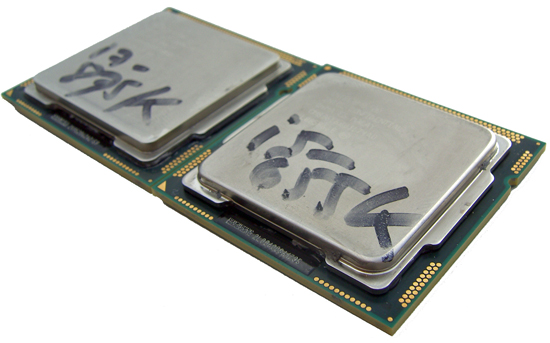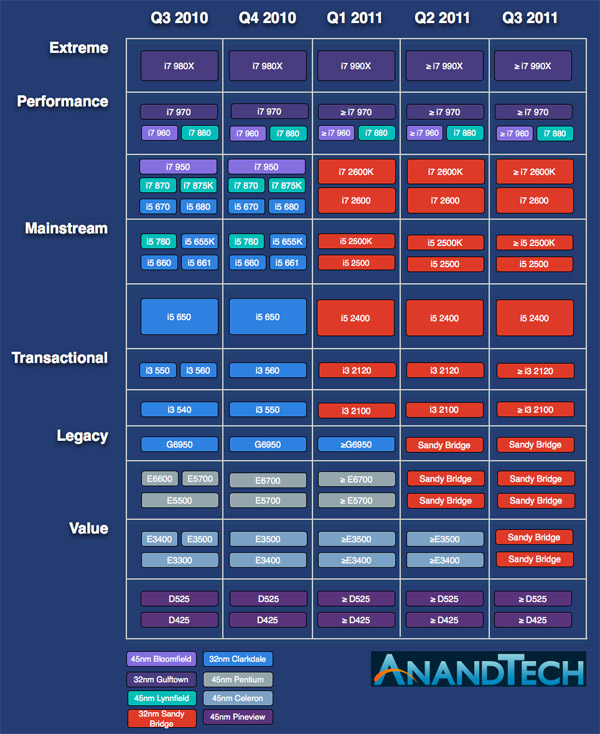Intel's Sandy Bridge Architecture Exposed
by Anand Lal Shimpi on September 14, 2010 4:10 AM EST- Posted in
- CPUs
- Intel
- Sandy Bridge
Multiplier-only Overclocking
There's no new information on Sandy Bridge overclocking at this point (although it's looking increasingly likely that there will be a reasonably priced K-series SKU for those users who want the flexibility to overclock without spending $1000). I've included the overclocking text and roadmap from our Sandy Bridge Preview below if you're interested in seeing what Intel has planned.
It wasn’t until the Pentium II that Intel started shipping multiplier locked CPUs. Before then you could set the multiplier on your CPU to anything that was supported by the line, and if you had a good chip and good enough cooling you just overclocked your processor. Intel’s policies changed once remarking, the process of relabeling and reselling a lower spec CPU as a higher one, started to take off.
While multipliers were locked, Intel left FSB overclocking open. That would be an end user or system integrator decision and not something that could be done when selling an individual CPU. However, ever since before the Pentium III Intel had aspirations of shipping fully locked CPUs. The power of the enthusiast community generally kept Intel from exploring such avenues, but we live in different times today.
Two things have changed Intel’s feelings on the topic. First and foremost is the advent of Turbo Boost. So long as Intel doesn’t artificially limit turbo modes, we now have the ability to run CPUs at whatever clock speed they can run at without exceeding thermal or current limits. We saw the first really exciting Turbo with Lynnfield, and Sandy Bridge is going to expand on that as well. On the flip side, Intel has used Turbo as a marketing differentiator between parts so there’s still a need to overclock.
The second major change within Intel is the willingness to directly address the enthusiast community with unlocked K-series SKUs. We saw this recently with the Core i7 875K and Core i5 655K parts that ship fully unlocked for the overclocking community.

The K-series SKUs, these will be more important with Sandy Bridge
With Sandy Bridge, Intel integrated the clock generator, usually present on the motherboard, onto the 6-series chipset die. While BCLK is adjustable on current Core iX processors, with Sandy Bridge it’s mostly locked at 100MHz. There will be some wiggle room as far as I can tell, but it’s not going to be much. Overclocking, as we know it, is dead.
Well, not exactly.
Intel makes three concessions.
First and foremost we have the K-series parts. These will be fully unlocked, supporting multipliers up to 57x. Sandy Bridge should have more attractive K SKUs than what we’ve seen to date. The Core i7 2600 and 2500 will both be available as a K-edition. The former should be priced around $562 and the latter at $205 if we go off of current pricing.
Secondly, some regular Sandy Bridge processors will have partially unlocked multipliers. The idea is that you take your highest turbo multiplier, add a few more bins on top of that, and that’ll be your maximum multiplier. It gives some overclocking headroom, but not limitless. Intel is still working out the details for how far you can go with these partially unlocked parts, but I’ve chimed in with my opinion and hopefully we’ll see something reasonable come from the company. I am hopeful that these partially unlocked parts will have enough multipliers available to make for decent overclocks.
Finally, if you focus on multiplier-only overclocking you lose the ability to increase memory bandwidth as you increase CPU clock speed. The faster your CPU, the more data it needs and thus the faster your memory subsystem needs to be in order to scale well. As a result, on P67 motherboards you’ll be able to adjust your memory ratios to support up to DDR3-2133.
Personally, I’d love nothing more than for everything to ship unlocked. The realities of Intel’s business apparently prevent that, so we’re left with something that could either be a non-issue or just horrible.
If the K-series parts are priced appropriately, which at first indication it seems they will be, then this will be a non-issue for a portion of the enthusiast market. You’ll pay the same amount for your Core i7 2500K as you would for a Core i5 750 and you’ll have the same overclocking potential.
Regardless of how they’re priced, what this is sure to hurt is the ability to buy a low end part like the Core i3 530 and overclock the crap out of it. What Intel decides to do with the available multiplier headroom on parts further down the stack is unknown at this point. If Intel wanted to, it could pick exciting parts at lower price points, give them a few more bins of overclocking headroom and compete in a more targeted way with AMD offerings at similar price points. A benevolent Intel would allow enough headroom as the parts can reliably hit with air cooling.
The potential for this to all go very wrong is there. I’m going to reserve final judgment until I get a better idea for what the Sandy Bridge family is going to look like.











62 Comments
View All Comments
yuhong - Tuesday, September 14, 2010 - link
There is no VEX.256 for 256-bit integer ops, but there is a VEX.128 prefix that zeros the upper part of YMM registers to reduce the delays..NaN42 - Tuesday, September 14, 2010 - link
Well, I found a summary of the prefixes. Interestingly there are some exception, like I guessed, e.g. a VEX.128 prefix does not exist for conversion of packed floating points<->packed integers and for CRC32c + POPCNT.CSMR - Tuesday, September 14, 2010 - link
Anand:The best info available on an exciting platform, good job.
I wonder if for the next article you could test DirectX / OpenGL compatibility? Intel advertises compliance for a lot of its products, but in reality the support is partial, and some applications that use DirectX / OpenGL entirely correctly are not supported by Intel graphics, including the current HD graphics.
I've found this with fastpictureviewer (DirectX, I think 9) and Photoshop CS5 (OpenGL 2)
This is quite shocking. Given that Intel is doing this currently, it would be great if reviewers could prod it into action, but unfortunately they tend to place speed first, correctness second or nowhere.
marass31 - Thursday, September 16, 2010 - link
Hi CSMR,Could you please write more details about problems with DX and OGL on Intel HD graphics( including gfx driver version, system config ...). You mentioned about two applications: Fastpictureviewer and PSCS5, so could you please write some steps to reproduce to each of them - THX a lot.
ssj4Gogeta - Tuesday, September 14, 2010 - link
What's the point of extreme editions if we're going to have affordable K SKUs?Or will socket 2011 not have any K SKUs? I'm guessing they'll leave the BCLCK unlocked on the 2011, and only have normal and extreme processors (no K processors). Or maybe extreme editions will just have more cores like 980X?
DanNeely - Tuesday, September 14, 2010 - link
The extreme editions have always been for people who buy retail or who're playing with LN2 and need the most insanely binned part available. They've never been a mainstream OCer part.MonkeyPaw - Tuesday, September 14, 2010 - link
I have a bad feeling about the "k" chips and the future of overclocking. Sure, intel gave us turbo mode, but that almost seems like appeasement before the last shoe drops. First, limited turbo with good overclockng, then better turbo and less overclocking, and now it's sounding like slightly better turbo and even less overclocking. It looks like we are moving to intel-controlled overclocking. There's virtually no value left for the enthusiast--a user that is already just a small part of the market. Intel just decided what the enthusiast needs, but I don't think they get what those users actually want.I just don't buy that these limits are to prevent fraud. Mom and Pop stores are virtually all gone now, and I'd hate to think what Intel would do to a Dell or HP if they got caught overclocking desktops.
I guess this leaves another door open for AMD. Sad, cause SnB looks like a great design.
This Guy - Wednesday, September 15, 2010 - link
Hopefully Intel will allow the 'energy budget' to be increased when an extreme edition processer detects less thermal resistance (i.e. a bloody big heat sink). This would allow an EE CPU to either run with a higher multiplier or run at it's turbo frequency longer. (I'ld like this feature on all CPU's)This would make EE CPU's interesting if K CPU's catch up in terms of cores.
Shadowmaster625 - Tuesday, September 14, 2010 - link
What are the prospects for using Intel's transcoder to convert DVDs to 700MB avi files? Either DivX, Xvid, or H.264? Or anything else better than MPEG-2?Dfere - Tuesday, September 14, 2010 - link
Since this seems to be, overall, a refinement, and not so much an improvement with new capabilities, and Anand's comments about the scalability of GPU related enhancements, that Intel is taking a two step approach towards CPU releases, in addition to its fab strategies? E.G, we see a new CPU, then it gets shrunk, then it gets improved (like this), then it gets bells and whistles (like a GPU etc), then we start over again with a really new architecture.....